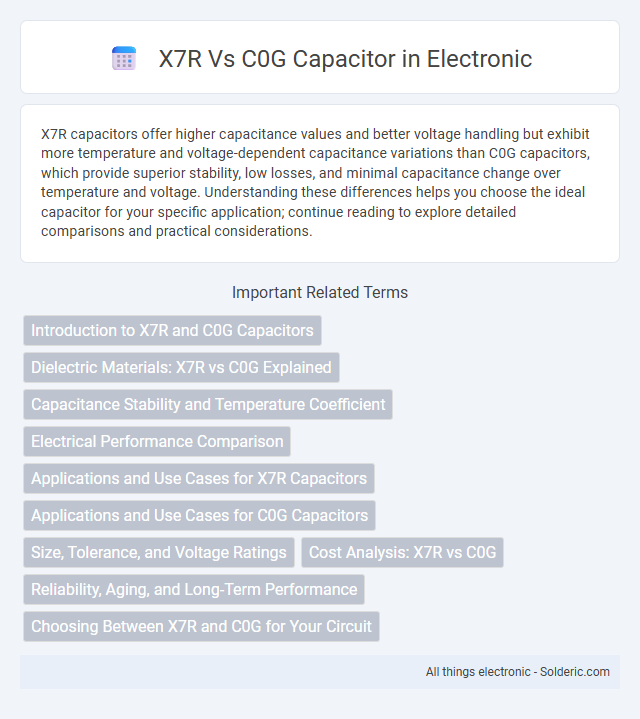X7R capacitors offer higher capacitance values and better voltage handling but exhibit more temperature and voltage-dependent capacitance variations than C0G capacitors, which provide superior stability, low losses, and minimal capacitance change over temperature and voltage. Understanding these differences helps you choose the ideal capacitor for your specific application; continue reading to explore detailed comparisons and practical considerations.
Comparison Table
| Feature | X7R Capacitor | C0G Capacitor |
|---|---|---|
| Dielectric Type | Class II ceramic | Class I ceramic |
| Temperature Stability | +-15% over -55degC to +125degC | +-30ppm/degC over -55degC to +125degC |
| Capacitance Range | 1pF to 10uF | 1pF to 1uF |
| Dielectric Loss (Dissipation Factor) | Higher, typically 1-5% | Very low, typically <0.1% |
| Voltage Ratings | Typically 16V to 100V | Typically 50V to 500V |
| Applications | Decoupling, filtering, general purpose | High stability analog circuits, RF, precision timing |
| Cost | Lower | Higher |
| Stability Over Time | Limited, capacitance can change | Excellent, minimal drift |
Introduction to X7R and C0G Capacitors
X7R and C0G capacitors are popular ceramic capacitor types distinguished by their temperature stability and dielectric properties, where X7R offers moderate capacitance stability over a temperature range of -55degC to 125degC, making it suitable for general-purpose applications. C0G capacitors, also known as NP0, provide superior stability with near-zero capacitance change across -55degC to 125degC, ideal for precision circuits requiring consistent performance. Understanding the difference between these types helps you select the right capacitor to optimize circuit reliability and performance.
Dielectric Materials: X7R vs C0G Explained
X7R capacitors use a ceramic dielectric made from barium titanate-based materials, offering high permittivity and moderate thermal stability with capacitance changes up to +-15% over a temperature range of -55degC to 125degC. C0G capacitors employ a titanium dioxide-based dielectric, known for its extremely stable electrical properties, exhibiting near-zero temperature coefficient and minimal capacitance variation (+-30 ppm/degC) across -55degC to 125degC. The differences in dielectric composition directly impact the linearity, stability, and precision suitability of X7R versus C0G capacitors in electronic circuits.
Capacitance Stability and Temperature Coefficient
X7R capacitors offer higher capacitance values but have a wider capacitance tolerance and a temperature coefficient of +-15%, resulting in significant capacitance variation with temperature changes. C0G capacitors provide excellent capacitance stability with a near-zero temperature coefficient (+-30 ppm/degC), maintaining consistent performance across temperature ranges. For applications requiring precise capacitance and minimal temperature-induced drift, C0G capacitors are preferred despite their lower capacitance values compared to X7R.
Electrical Performance Comparison
X7R capacitors provide higher capacitance values and are suitable for applications requiring temperature stability from -55degC to +125degC, with capacitance variation up to +-15%. C0G capacitors exhibit superior electrical performance with near-zero temperature coefficient, extremely low dielectric losses, and stable capacitance over a wide temperature range (-55degC to +125degC), making them ideal for precision timing and filtering circuits. The trade-off is that C0G capacitors typically have lower capacitance values compared to X7R capacitors, limiting their use in high-capacitance applications.
Applications and Use Cases for X7R Capacitors
X7R capacitors are commonly used in applications requiring stable capacitance over a wide temperature range, such as in power supply filtering, decoupling, and bypass circuits in consumer electronics and automotive systems. Their ability to handle moderate dielectric constant changes makes them suitable for general-purpose use where size and cost are important but precision is less critical than in C0G capacitors. Your electronics designs benefit from X7R capacitors when balancing performance and affordability in environments with fluctuating temperatures.
Applications and Use Cases for C0G Capacitors
C0G capacitors are widely used in precision applications such as RF circuits, oscillators, and filters due to their excellent temperature stability and low dielectric loss. These capacitors ensure consistent capacitance across a broad temperature range, making them ideal for timing circuits, sensor readouts, and high-frequency applications. Their reliable performance under varying environmental conditions supports use in aerospace, medical devices, and instrumentation systems.
Size, Tolerance, and Voltage Ratings
X7R capacitors offer higher volumetric efficiency with smaller sizes compared to C0G types, making them ideal for space-constrained applications. X7R capacitors typically have wider tolerance ranges of +-15%, while C0G capacitors provide tight tolerances around +-5%, ensuring greater precision in circuit performance. Voltage ratings for X7R capacitors commonly range from 16V to 50V, whereas C0G capacitors support similar voltages but maintain stability better under temperature and voltage fluctuations.
Cost Analysis: X7R vs C0G
X7R capacitors generally offer a lower cost per unit compared to C0G capacitors due to their ceramic composition and higher volumetric efficiency. While C0G capacitors provide superior temperature stability and reliability, their manufacturing complexity leads to higher prices. Cost-sensitive applications often favor X7R capacitors, especially when tight tolerance and low drift are less critical.
Reliability, Aging, and Long-Term Performance
X7R capacitors offer higher capacitance values but exhibit greater capacitance variability and aging over time due to temperature and voltage stresses, impacting long-term reliability. C0G capacitors provide superior stability with minimal capacitance change, low dielectric loss, and excellent reliability, making them ideal for precision applications requiring consistent performance. Your choice between X7R and C0G should weigh the trade-offs between capacitance density and the need for long-term stability in the circuit design.
Choosing Between X7R and C0G for Your Circuit
X7R capacitors offer higher capacitance values and better volumetric efficiency, making them ideal for decoupling and bulk storage in circuits where some capacitance variation with temperature is acceptable. C0G capacitors provide superior stability, low loss, and minimal capacitance change over temperature and voltage, which is critical for precision timing, filtering, and resonant circuits. Selecting between X7R and C0G depends on application requirements: prioritize X7R for cost-effective, higher capacitance needs and C0G for demanding, stable performance with tight tolerances.
X7R vs C0G capacitor Infographic

 solderic.com
solderic.com